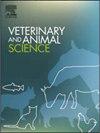Investigating the use of Chenopodium quinoa to improve rumen biofermentability and reduction of methane and carbon dioxide production
IF 1.9
Q2 AGRICULTURE, DAIRY & ANIMAL SCIENCE
引用次数: 0
Abstract
Quinoa forage can be used as a sustainable source of ruminants to reduce environmental pollution. This study aimed to assess the chemical composition, in vitro fermentation and in situ degradability of quinoa forage in harvestable stages and compare the nutritional value of this forage with alfalfa. Experimental treatments were: Al, alfalfa forage; Q45, Q95 and Q125, quinoa harvested 45, 95 and 125 days after planting respectively. The increment of harvesting time in quinoa increased the quantities of NDFom, ADFom and ADL but reduced the contents of CP, EE, total phenolics (TP), total tannins (TT), in vitro organic matter digestibility (IVOMD) and metabolizable energy (ME) (P < 0.0001). Total VFAs were decreased in Q125 and Q145 treatments versus Al treatment and this VFA decreased with increasing plant age (P < 0.0001). The concentration of acetate and the acetate to propionate ratio (P < 0.0001) in quinoa forages were lower, while the concentration of propionate was higher than that in the alfalfa (P = 0.0002). Applying quinoa forage reduced CH4 production (P = 0.0002) and NH3-N concentration (P = 0.0004), total protozoa (P < 0.0001), subfamilies of Entodiniinae (P < 0.0001) Ophrioscolecinae (P = 0.029) in comparison with Al. The amounts of fresh and dry quinoa forages/ha and WU and WUE increased with the quinoa growing (P < 0.0001). Applying quinoa forage in ruminant's diets may be a substitute answer to ecological problems in some areas where usual plants cannot grow as a result of the salinity and dryness of the soil.
研究藜麦对提高瘤胃生物可发酵性和减少甲烷和二氧化碳产量的作用
藜麦饲草可作为反刍动物的可持续来源,以减少环境污染。本研究旨在评估藜麦牧草在可收获阶段的化学成分、体外发酵和就地降解性,并比较这种牧草与紫花苜蓿的营养价值。实验处理为Al:紫花苜蓿饲草;Q45、Q95 和 Q125:藜麦分别在播种后 45、95 和 125 天收获。藜麦收割时间的延长增加了 NDFom、ADFom 和 ADL 的含量,但降低了 CP、EE、总酚(TP)、总单宁(TT)、体外有机物消化率(IVOMD)和代谢能(ME)的含量(P < 0.0001)。与 Al 处理相比,Q125 和 Q145 处理中的总挥发性脂肪酸有所减少,而且这种挥发性脂肪酸随着植株年龄的增加而减少(P < 0.0001)。藜麦饲草中乙酸盐浓度和乙酸盐与丙酸盐的比率(P <0.0001)低于紫花苜蓿,而丙酸盐浓度高于紫花苜蓿(P = 0.0002)。与苜蓿相比,施用藜麦饲草可降低 CH4 产量(P = 0.0002)和 NH3-N 浓度(P = 0.0004)、原生动物总数(P < 0.0001)、Entodiniinae 亚科(P < 0.0001)和 Ophrioscolecinae 亚科(P = 0.029)。随着藜麦的生长,新鲜和干藜麦饲草量/公顷、WU 和 WUE 都有所增加(P < 0.0001)。在反刍动物日粮中添加藜麦饲草可能是解决某些地区因土壤盐碱化和干燥而无法种植普通植物的生态问题的替代方法。
本文章由计算机程序翻译,如有差异,请以英文原文为准。
求助全文
约1分钟内获得全文
求助全文
来源期刊

Veterinary and Animal Science
Veterinary-Veterinary (all)
CiteScore
3.50
自引率
0.00%
发文量
43
审稿时长
47 days
 求助内容:
求助内容: 应助结果提醒方式:
应助结果提醒方式:


